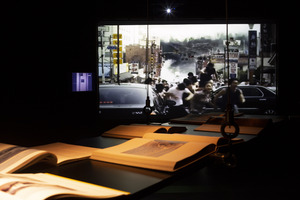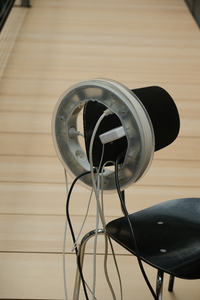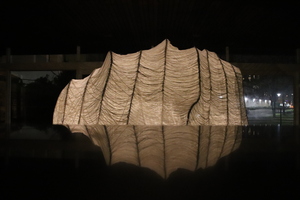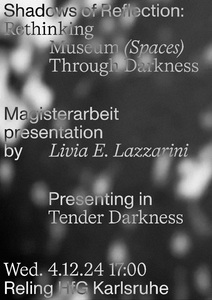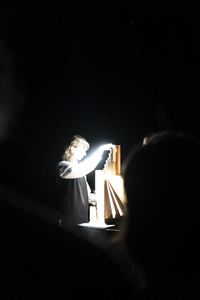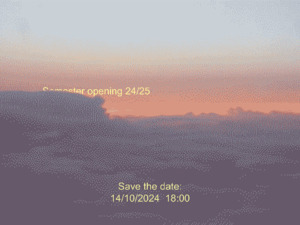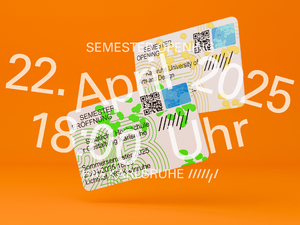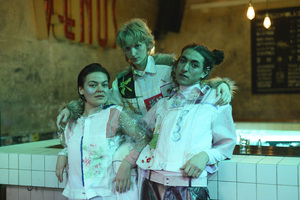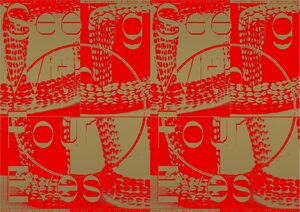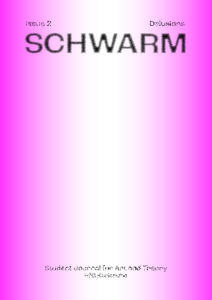weisse vernunft – siedlungsbau der 20er jahre
Benachbarte Sets (106)Alle Zusammenhänge anzeigen
Diese Sets wurden den gleichen Sets hinzugefügt wie das ausgewählte Set.
106 Inhalte
- Seite 1 von 9
Tide
- Titel
- Tide
- Titel (en)
- Tide
- Autor/in
- Beschreibung (de)
- Gezeiten sind dem Zyklus von Sonne, Erde und Mond unterworfen. Sie sind die Bewegung der Wassermassen des Ozeans, die an den Küsten als periodisches Ansteigen und Absinken des Meeresspiegels in Erscheinung tritt. [...] Gezeiten als Daseinsmetapher umreißen das fortlaufende Ausbalancieren von Kommen und Gehen, Anziehen und Abstoßen, Sich zeigen und entziehen. [...] "Tide" überträgt dieses Verständnis der Gezeiten in eine kontinuierliche, non-lineare Bewegung im Ausstellungsraum.
- Beschreibung (en)
- Tides are subject to the cycle of the sun, earth and moon. They are the movement of the water masses of the ocean, which appears on the coasts as a periodic rise and fall of the sea level. [...] Tides as a metaphor for existence outline the continuous balancing of coming and going, attracting and repelling, showing and withdrawing. [...] "Tide" translates this understanding of the tides into a continuous, non-linear movement in the exhibition space.
- Kategorie
- Schlagworte
- Datierung
- 01.07.2020 - 05.07.2020
- Dank an
- Francesca Audretsch
- Patrick Alan Banfield
- Lisa Bergmann
- Matthias Bruhn
- Anja Casser
- Hans Christ (Hans D. Christ)
- Jaya Demmer
- Hubert Distel
- Anja Dorn
- Lizzy Ellbrück
- Hanna Franke
- Christoph Funk
- Laurine Haller
- Maria Harder-Scheib
- Sascha Jungbauer
- Lydia Kähny
- Tobias Keilbach
- Iden Sungyoung Kim
- Alexander Knoppik
- Hanne König
- Susanne Kriemann
- Judith Milz
- Paulina Mimberg
- Andrej Mircev
- Andreas Müller
- Viktor Neumann
- Leonie Ohlow
- Jonas Piroth
- Anja Ruschival
- Thomas Rustemeyer
- Friederike Schäfer
- Sebastian Schäfer
- Karl-Heinz Scheib
- Ivo Scheib
- Corinna Scheib
- Josefine Scheu
- Hendrik Stoerk
- Lioudmila Voropai
- Leia Morgana Walz
- Petra Zimmermann
- Ort: Institution
- Ort
- Großes Studio
- Stadt
- Land
- Titel
- Tide
- Projektleiter/in
- Semester
- Studiengang
- Typ der Abschlussarbeit
- Importiert am
- 14.06.2024
- Übergeordnete Sets
- 2
- Set enthält
- 0 15
Testzentrum für chronischen Automobilismus
- Titel
- Testzentrum für chronischen Automobilismus
- Autor/in
- Beschreibung (de)
- Radweg Ende, kein Zebrastreifen, Parkplatz voll, Bahn verpasst and stop and go, jemand hupt alle schauen, rote Ampel niemand da, falsch abgebogen, Licht vergessen, vollgas Lichthupe, Überholmaneuver trotz Geschwindigkeitsbegrenzung, ups! Personenschaden, Spiegel abgebrochen, Fenster runter „Arschloch!“, selber! Brumm. Kennen Sie das?
Verkehr ist eine höchst emotionale Angelegenheit. Die vielen kleinen Entscheidungen, die wir im automobilen Individualverkehr treffen müssen, sind immer auch mit einem Risiko behaftet. Sehen wir den "Personenschaden" als Katastrophe an, so müssen wir doch zugeben, dass auch die kleinen Fehlentscheidungen für Stress, Frust und Wut sorgen können. Ebendiese Reaktionen möchten wir im Kontext der sogenannten Mobilitätswende anerkennen, attestieren und aus ihnen Forderungen ableiten, die wir gerne für unsere Besucher*innen an die lokalen Behörden weiterleiten.
Auto, Fahrrad, Zufuß? Egal! Unsere 20-minütige Erstuntersuchung richtet sich an alle Verkehrsteilnehmer*innen. Erfahren Sie fachkundige Beratung und die Anwendung neuester Technologie. Tipp: Buchen Sie schon jetzt einen Termin und vermeiden Sie Wartezeiten. Wir freuen uns auf ihren Besuch!
- Radweg Ende, kein Zebrastreifen, Parkplatz voll, Bahn verpasst and stop and go, jemand hupt alle schauen, rote Ampel niemand da, falsch abgebogen, Licht vergessen, vollgas Lichthupe, Überholmaneuver trotz Geschwindigkeitsbegrenzung, ups! Personenschaden, Spiegel abgebrochen, Fenster runter „Arschloch!“, selber! Brumm. Kennen Sie das?
- Kategorie
- Typ des Projekts/Werks
- Schlagworte
- Datierung
- 25.03.2024 - 28.03.2024
- Mitwirkende
- Sprache
- Material
- Technik/Verfahren/Formate
- GameMaker Studio 2 (Game)
- Abmessungen
- 5 x 7,5 m
- Dauer
- 25 Minuten (Erstuntersuchung)
- Ort: Institution
- Stadt
- Land
- Internetlinks
- Bemerkungen
- Dank an: Alexander Knoppik, Alexander Thelen, Anna Haas (Badisches Staatstheater), Astrid Lindner-Maier, Barbara Kuon, Charlotte Singer, Christian Platz, Cornelia Herzog, Daniel Heiss (ZKM), Dario Schmid, Emelie Schreiner, Felix Fisgus, Franzi Wentz, Isabelle Schneider, Julian Kuf, Laura Richter, Leonie Mühlen, Martin Mangold (ZKM), Marvin Uhde (cant-deci.de), Max Bernhard, Miri, Omni-Mobil GmbH, Paula Schacke (die Anstoss e.V.), Pavel Polenz, Ralph Saam (Scheck-In Center Durlach), Richard Brunner, Sebastian Schäfer, Sebastian Schillbach, Sebastian Schönfeld, Silke Roth (die Anstoss e.V.), Susanne Henneberger (WERKRAUM: Karlsruhe e.V.), Susanne Schmitt, Sven Krahl, Timothée Charon, Tobias Keilbach, Tjark Schönfeld, Ute Wienberg (Badisches Staatstheater), Vlado Petrovic, Waldemar Schwab, Yun-Wen Liu
- Dank an: Alexander Knoppik, Alexander Thelen, Anna Haas (Badisches Staatstheater), Astrid Lindner-Maier, Barbara Kuon, Charlotte Singer, Christian Platz, Cornelia Herzog, Daniel Heiss (ZKM), Dario Schmid, Emelie Schreiner, Felix Fisgus, Franzi Wentz, Isabelle Schneider, Julian Kuf, Laura Richter, Leonie Mühlen, Martin Mangold (ZKM), Marvin Uhde (cant-deci.de), Max Bernhard, Miri, Omni-Mobil GmbH, Paula Schacke (die Anstoss e.V.), Pavel Polenz, Ralph Saam (Scheck-In Center Durlach), Richard Brunner, Sebastian Schäfer, Sebastian Schillbach, Sebastian Schönfeld, Silke Roth (die Anstoss e.V.), Susanne Henneberger (WERKRAUM: Karlsruhe e.V.), Susanne Schmitt, Sven Krahl, Timothée Charon, Tobias Keilbach, Tjark Schönfeld, Ute Wienberg (Badisches Staatstheater), Vlado Petrovic, Waldemar Schwab, Yun-Wen Liu
- Titel
- Testzentrum für chronischen Automobilismus
- Projektleiter/in
- Semester
- Studiengang
- Typ der Abschlussarbeit
- Importiert am
- 31.05.2024
- Übergeordnete Sets
- 2
- Set enthält
- 0 0
Stromkreis
- Titel
- Stromkreis
- Titel (en)
- cirquit
- Autor/in
- Beschreibung (de)
- Die kreisförmige Mehrfachsteckdose gibt einem oft unbeachteten
Alltagsobjekt eine Stimme.
Der Kreis steht dabei sinnbildlich für Ordnung, Übersicht und Bewegung.
Anders als klassische Steckleisten, die sich in Ecken drängen lassen,
behauptet dieses Objekt seine Präsenz –
es verweigert das Verstecktsein und fühlt sich im Zentrum des Raums am
wohlsten.
Durch die mehrdirektionale Anordnung lassen sich Geräte aus allen
Richtungen mit Strom versorgen – eine Auflösung der linearen Nutzung
zugunsten räumlicher Offenheit.
Bis zu sieben Meter Kabel, die außen aufgewickelt werden, ermöglichen eine
flexible Nutzung in unterschiedlichsten Raumsituationen.
Die transparente Gestaltung der Seitenteile aus Plexiglas fördert ein neues
Bewusstsein für das Objekt – sie macht Funktion sichtbar und
Haltung greifbar.
So wird aus einem technischen Alltagsgegenstand ein
flexibler Begleiter, der sichtbar, nutzbar und verständlich
im Raum existiert.
- Die kreisförmige Mehrfachsteckdose gibt einem oft unbeachteten
- Beschreibung (en)
- The circular multiplug gives a voice to an often unnoticed everyday object. Here the circle symbolizes order, overview and movement. Unlike classic power strips, which can be pushed into corners, this object asserts its presence - it refuses to be hidden and feels most comfortable in the center of the room. The multi-directional arrangement allows devices to be supplied with power from all directions - a dissolution of linear use in favour of spatial openness. Up to seven meters of cable, which are wound up on the outside, enable flexible use in a wide variety of room situations. The transparent design of the Plexiglas side panels promotes a new awareness of the object - it makes function visible and attitude tangible. This turns an everyday technical object into a flexible companion that is visible, usable and understandable in the room.
- Kategorie
- Typ des Projekts/Werks
- Datierung
- 22.07.2025
- Titel
- Stromkreis
- Projektleiter/in
- Studiengang
- Importiert am
- 18.07.2025
- Übergeordnete Sets
- 1
- Set enthält
- 0 9
Sorry I’ve been busy while you were dying
- Titel
- Sorry I’ve been busy while you were dying
- Titel (en)
- Sorry I’ve been busy while you were dying
- Autor/in
- Beschreibung (de)
- Würde man den Künstler danach fragen, würde er einem vermutlich die gleiche Auskunft geben, daher nehme ich an, dass auch ich alles Folgende sagen darf:
Felix Buchholz hat in der Gellertstraße 14, einer alten Fabrikantenvilla in der Karlsruher Weststadt, im Juli 2018, die Wohnung seiner verstorbenen Großmutter rekonstruiert. Die Wände und Decken dieser Rekonstruktion bestehen aus zusammengenähten Stoffen aus ebenjener Wohnung, die an einem nicht sichtbaren Hängekonstrukt angebracht sind. Man betritt die „Wohnung“, die Installation, per Konzept alleine, ohne Schuhe und solange man will.
Als ich sie betrete, weiß ich, dass Felix Buchholz die einzige Person war, zu der seine Großmutter überhaupt noch Kontakt hatte vor ihrem Tod, er hat mir erzählt, wie ihre gemeinsamen Treffen verlaufen sind, was sie dann taten, wie es in ihrer Wohnung aussah, die sie zuletzt eigentlich kaum mehr verließ, was er über ihr Leben wusste, ihre Eigenheiten und Ansichten, und was das mit seinem Vater, seiner Mutter und seiner eigenen Biografie zu tun hatte. Ich wusste, dass er eines Tages zu einem, wie immer, per Postkarte angekündigten Besuch vorbeikommen wollte und sie zum ersten Mal nicht öffnete, und dass, als die Polizei ihm ein paar Stunden später die Tür aufbrach, sich herausstellte, dass das nicht zum ersten Mal passierte, sondern bereits einige Tage zuvor das Gleiche passiert war, auf Anruf der Nachbarn hin, wegen des Geruchs. Und dass sie nur zwei Tage zuvor, vor seinem Besuch, alleine beerdigt worden sei. Von ihrer eigenen Beerdigung hatte sie eine genaue Vorstellung, die sie mit Felix abgesprochen hatte. So ist es unweit mehr als eine verpasste Chance, ein Abschiedsritual, bei dem allen voran Felix Buchholz nicht Abschied nehmen konnte.
Als ich die Installation betrete, habe ich im Nacken, die Vorstellung ebenjener Person und so mein ich dann manchmal mich umdrehen zu müssen, obwohl ich weiß, dass ich allein in der Stoffwohnung bin. Ich geh ins Wohn-/Schlafzimmer, dort steht, zentral, ein Bett, ein Sarg, eine Totenaufbahrung, in die man sich legen kann, oder soll, oder man soll sich zumindest fragen ob man sich hineinlegen soll oder eben nicht. Oben drauf ist Lavendel gepflanzt, Stoffe, Motten, Lavendel, und als ich mich hinlege gehen drinnen im Sarkophag hinter Stoff verkleidete Leuchtstoffröhren an, sie klicken und brummen, und ich erschrecke mich zu Tode. Ein bisschen ist das jetzt wie auf dem Seziertisch zu liegen, aber es ist auch nicht so unangenehm, dass ich sofort wieder gehen möchte. Beobachtet komme ich mir noch immer vor, so, als ob ich durch die von außen beleuchteten dünnen Stoffwände von dem Künstler, also Felix Buchholz, vielleicht beobachtet werden würde.
Deutungshoheit zu haben ist ein genuin künstlerisches Moment, nur, je mehr eine Geschichte den Anspruch auf eine individuelle Erfahrung, oder Authentizität hat, desto schleichender kommt die Einsicht, dass mit dem angenommenen Tod seiner Großmutter Felix in jeglichen Sinne zu ihrem Alleinerben geworden ist, zur Deutungshoheit auch über ihr Leben, und so zelebriert er hier eine zweite Totenwache. Im Bad geht ein Fön an, ich denke, aha, es ist doch jemand zweites hier, vorher erschrecke ich zu Tode durch das Geräusch, das mich aus meiner arglosen Haltung, der kontemplativen Situation reist. Ich schleiche mich ins Bad, wo einige Föns von der Decke hängen, die jetzt wild im Raum hin- und herschlackern, vom Rückstoß des Föndrucks, der aus dem Nichts gekommen sein muss. Im Flur, der auch, weiß ich, hat er mir erzählt, als Küche genutzt wurde, gibt es ein kleines Stoffloch, eine Höhle für den Kopf in der Wand, eine Aufforderung sich auf den Rücken zu legen und das darin laufende Video über sich anzusehen, von der originalen, nur leergeräumten Wohnung, während Felix die Wohnung beschreibt. Während ich da liege und meine Füße, abgetrennt von meinem Kopf aufgestellt in dem Flur seiner verstorbenen Großmutter liegen, denke ich, wenn sie das sehen könnte, das wäre eine sehr schöne One Minute Sculpture. Also, ich werde das Gefühl nicht los, man beobachtet mich.
35qm sind es insgesamt, einmal geh ich noch durch die Wohnung, auf dem Weg nach draußen ziehe ich meine Schuhe wieder an, ihre stehen noch immer fein aufgereiht da. Im Foyer der Gellertstraße 14, in dem man sich jetzt wieder befindet, findet man auf dem dort an der Treppe angebrachten Lift liegt ein bedrucktes Handtuch liegen, bedruckt mit einem Foto der Frau, die Felix Großmutter ist. Sie hat ein Kleidungsstück mit Leoprint an und sieht sehr schick aus damit, ein bisschen makaber ist das schon, sie liegt da so flach auf dem Treppenlift, sieht aber ganz zufrieden dabei aus. Daneben findet sich am Boden so eine Art Schrein, und über all dem hängt eine schwarze Flagge, eben, Totenwache. Und Felix, der Totenwächter?, weil, was man nicht vergessen darf, niemand hat sich die Ausstellung angesehen, ohne, dass er die Haustür geöffnet hat, und ohne, dass er wieder da war, wenn man rauskam. Wenn man dann mit ihm gesprochen hat, haben drinnen die Föns immer noch weitergeturnt von Zeit zu Zeit und vielleicht hat er einem dann erst mal ein Glas Leitungswasser angeboten.
Text von Judith Milz.
- Würde man den Künstler danach fragen, würde er einem vermutlich die gleiche Auskunft geben, daher nehme ich an, dass auch ich alles Folgende sagen darf:
Felix Buchholz hat in der Gellertstraße 14, einer alten Fabrikantenvilla in der Karlsruher Weststadt, im Juli 2018, die Wohnung seiner verstorbenen Großmutter rekonstruiert. Die Wände und Decken dieser Rekonstruktion bestehen aus zusammengenähten Stoffen aus ebenjener Wohnung, die an einem nicht sichtbaren Hängekonstrukt angebracht sind. Man betritt die „Wohnung“, die Installation, per Konzept alleine, ohne Schuhe und solange man will.
Als ich sie betrete, weiß ich, dass Felix Buchholz die einzige Person war, zu der seine Großmutter überhaupt noch Kontakt hatte vor ihrem Tod, er hat mir erzählt, wie ihre gemeinsamen Treffen verlaufen sind, was sie dann taten, wie es in ihrer Wohnung aussah, die sie zuletzt eigentlich kaum mehr verließ, was er über ihr Leben wusste, ihre Eigenheiten und Ansichten, und was das mit seinem Vater, seiner Mutter und seiner eigenen Biografie zu tun hatte. Ich wusste, dass er eines Tages zu einem, wie immer, per Postkarte angekündigten Besuch vorbeikommen wollte und sie zum ersten Mal nicht öffnete, und dass, als die Polizei ihm ein paar Stunden später die Tür aufbrach, sich herausstellte, dass das nicht zum ersten Mal passierte, sondern bereits einige Tage zuvor das Gleiche passiert war, auf Anruf der Nachbarn hin, wegen des Geruchs. Und dass sie nur zwei Tage zuvor, vor seinem Besuch, alleine beerdigt worden sei. Von ihrer eigenen Beerdigung hatte sie eine genaue Vorstellung, die sie mit Felix abgesprochen hatte. So ist es unweit mehr als eine verpasste Chance, ein Abschiedsritual, bei dem allen voran Felix Buchholz nicht Abschied nehmen konnte.
- Typ des Projekts/Werks
- Schlagworte
- Datierung
- 2018
- Mitwirkende
- Sprache
- Ort
- Villa Gellert, Gellertstraße 14
- Stadt
- Land
- Titel
- Sorry I’ve been busy while you were dying
- Projektleiter/in
- Semester
- Studiengang
- Typ der Abschlussarbeit
- Importiert am
- 24.05.2023
- Übergeordnete Sets
- 2
- Set enthält
- 0 7
She and her, white and white
- Titel
- She and her, white and white
- Autor/in
- Beschreibung (de)
- Diese Ausstellung erzählt von mir, meiner Mutter und der Farbe Weiß, die für meine erste Erinnerung, Verzweiflung und letztlich Hoffnung steht. Weiß symbolisiert die Kraft, die mich immer wieder zum Ursprung zurückführt.
- Beschreibung (en)
- This exhibition is about me, my mother, and my connection to the world, exploring emotions through light, sound, and fog. White, my first memory from the womb, evolved from despair during personal crises to a symbol of hope and strength, guiding me back to life’s essence.
- Kategorie
- Typ des Projekts/Werks
- Schlagworte
- Datierung
- 04.12.2024
- Mitwirkende
- Dank an
- Sprache
- Material
- Abmessungen
- 2*3*4 M
- Dauer
- Die Gesamtlaufzeit des Audios beträgt zehn Minuten.
- Ort
- zkm Pavillon
- Stadt
- Land
- Titel
- She and her, white and white
- Projektleiter/in
- Semester
- Studiengang
- Typ der Abschlussarbeit
- Importiert am
- 12.12.2024
- Übergeordnete Sets
- 2
- Set enthält
- 0 10
Shadows of Reflection
- Titel
- Shadows of Reflection
- Untertitel
- Rethinking Museum (Spaces) Through Darkness
- Autor/in
- Beschreibung (de)
- In zeitgenössischen Museen können hell erleuchtete Räume - die so genannten „White Boxes“ - im Zusammenspiel mit Kunstwerken, die Szenen von Gewalt und Diskriminierung darstellen, befremdlich wirken. Auch wenn es wichtig ist, historische Ereignisse aufzuarbeiten und Minderheitengruppen sichtbar zu machen, kann der Kontrast zwischen der hellen Umgebung, dem behandelten Sachverhalt und der Realität selbst in diesen Kontexten zu einer Entfremdung führen.
Diese Magisterarbeit untersucht das Spannungsverhältnis zwischen hell erleuchteten Museumsräumen und der Darstellung schwieriger politischer Themen und schlägt dunkle Umgebungen als Gegennarrative vor. Keller, Bunker und Dunkelkammern können in diesem Sinne Erlösungsräume sein, die Platz für die Neudefinition von Machtstrukturen, für Freiheit und Emotionen lassen. Ein dunkler Raum ermöglicht somit transformative Erfahrungen, bei denen der Blick negiert und das Gefühl von Verletzlichkeit spürbar wird , was zu Überlegungen darüber einlädt, wie eine eingeschränkte Sichtbarkeit paradoxerweise unsere Fähigkeit, in einem umfassenderen, emotionaleren und bewussteren Sinne zu „sehen“, verstärken könnte. Dies wirft folgende Frage auf: Kann Dunkelheit emotionale Nähe fördern und neue Sichtweisen unterstützen?
- In zeitgenössischen Museen können hell erleuchtete Räume - die so genannten „White Boxes“ - im Zusammenspiel mit Kunstwerken, die Szenen von Gewalt und Diskriminierung darstellen, befremdlich wirken. Auch wenn es wichtig ist, historische Ereignisse aufzuarbeiten und Minderheitengruppen sichtbar zu machen, kann der Kontrast zwischen der hellen Umgebung, dem behandelten Sachverhalt und der Realität selbst in diesen Kontexten zu einer Entfremdung führen.
- Beschreibung (en)
- In contemporary museum spaces, the prevalence of brightly lit spaces – the so-called “white-boxes” – can be jarring when juxtaposed with artworks representing scenes of violence and discrimination. While it is essential to process historical events and give visibility to minority groups, in these contexts, the contrast between the bright environment, the subject matter and reality itself can create a disconnect.
This dissertation explores the tension between brightly lit museum spaces and their representation of challenging political subjects, proposing dark environments as a counter-narrative. Basements, bunkers and darkrooms, in this sense, can be redemption spaces that leave room for redefining power structures, for freedom and emotions. A dark space is thus a fundamental way of facilitating transformative experiences, where the gaze is negated and we all feel vulnerable, inviting considerations of how limited visibility might paradoxically enhance our ability to "see" in a broader, more emotionally and intentional engaged sense – raising the question: can darkness foster emotional proximity and encourage new ways of seeing?
- In contemporary museum spaces, the prevalence of brightly lit spaces – the so-called “white-boxes” – can be jarring when juxtaposed with artworks representing scenes of violence and discrimination. While it is essential to process historical events and give visibility to minority groups, in these contexts, the contrast between the bright environment, the subject matter and reality itself can create a disconnect.
- Kategorie
- Schlagworte
- Datierung
- 26.12.2024
- Sprache
- Titel
- Shadows of Reflection
- Projektleiter/in
- Semester
- Studiengang
- Typ der Abschlussarbeit
- Externes Archiv
- Importiert am
- 16.06.2025
- Übergeordnete Sets
- 0
- Set enthält
- 0 5
sentimental gentle rental
- Titel
- sentimental gentle rental
- Untertitel
- performance for a portative organ
- Autor/in
- Beschreibung (de)
- "sentimental gentle rental”, das Abschlussprojekt von Juliane Schmitt, ist eine Performance- und Soundinstallation, die sich um die Portativorgel dreht, ein Instrument, das im Mittelalter populär war. Die Arbeit basiert auf der Recherche über Nonnen in mittelalterlichen Klöstern. Die Portativorgel prägt die Aufführung durch ihren atemähnlichen Rhythmus. Die begrenzte Tonreichweite wird durch die Verwendung von Tools erweitert, um die Pfeifenlängen zu verändern. Dabei entsteht Reibung durch Obertöne, Dissonanzen und schwingende Frequenzen. Die Performerinnen synchronisieren ihren Atem mit dem Instrument und schaffen so ein zartes Gleichgewicht von Klang und Stille. Die Portativorgel, geliehen von einem Orgelbauer, wird damit zu einem Stellvertreterobjekt zarter Sentimentalität und zeitlich begrenzter Transzendenz.
- "sentimental gentle rental”, das Abschlussprojekt von Juliane Schmitt, ist eine Performance- und Soundinstallation, die sich um die Portativorgel dreht, ein Instrument, das im Mittelalter populär war. Die Arbeit basiert auf der Recherche über Nonnen in mittelalterlichen Klöstern. Die Portativorgel prägt die Aufführung durch ihren atemähnlichen Rhythmus. Die begrenzte Tonreichweite wird durch die Verwendung von Tools erweitert, um die Pfeifenlängen zu verändern. Dabei entsteht Reibung durch Obertöne, Dissonanzen und schwingende Frequenzen. Die Performerinnen synchronisieren ihren Atem mit dem Instrument und schaffen so ein zartes Gleichgewicht von Klang und Stille. Die Portativorgel, geliehen von einem Orgelbauer, wird damit zu einem Stellvertreterobjekt zarter Sentimentalität und zeitlich begrenzter Transzendenz.
- Beschreibung (en)
- "sentimental gentle rental” the graduation project by Juliane Schmitt is a performance and sound installation centered on the portative organ, an instrument that was popular in medieval times.
The work is based on research on nuns in medieval monasteries. The portative organ shapes the performance through its rhythmic breath-like cadence. The limited tonal range is expanded by using tools to adjust pipe lengths, producing higher tones and creating friction with overtones, dissonances, and oscillating frequencies. The performers synchronize their breath with the instrument, creating a delicate balance of sound and silence, transforming the organ that was borrowed from an organ builder into a vessel of gentle sentimentality and temporal transcendence.
- "sentimental gentle rental” the graduation project by Juliane Schmitt is a performance and sound installation centered on the portative organ, an instrument that was popular in medieval times.
- Kategorie
- Typ des Projekts/Werks
- Schlagworte
- Datierung
- 23.02.2024
- Mitwirkende
- Dank an
- Jonathan Blaschke
- Julius Bläser
- Pauline Cemeris
- Tamara Goerhinger
- Jana Hofmann
- Matthias Holznagel
- Line-Gry Hørup
- Bruno Jacoby
- Rafael Jörger
- Alexander Knoppik
- Vincent Krüger
- Mona Mayer
- Isabel Motz
- Nina Overkott
- Nis Petersen
- Tereza Ruller
- Sebastian Schäfer
- Josefine Scheu
- Isabel Seiffert
- Saskia van der Meer
- Mathis Walter
- Leia Morgana Walz
- Sprache
- Material
- Dauer
- 8 min – theoretically infinite
- Ort: Institution
- Ort
- Großes Studio
- Stadt
- Land
- Internetlinks
- Titel
- sentimental gentle rental
- Projektleiter/in
- Semester
- Studiengang
- Typ der Abschlussarbeit
- Importiert am
- 24.06.2024
- Übergeordnete Sets
- 2
- Set enthält
- 0 9
Semestereröffnung Wintersemester 2024/2025
- Titel
- Semestereröffnung Wintersemester 2024/2025
- Titel (en)
- Opening Winter Semester 2024/2025
- Beschreibung (de)
- An diesem Abend lädt die HfG Karlsruhe zur feierlichen Eröffnung des Wintersemesters ein und begrüßt zu diesem Anlass nicht nur Gäste und Freunde der Hochschule, sondern vor allem neue Studierende und Mitarbeitende sowie zwei Neuberufungen:
Prof. Charlotte Eifler (Professur für Mixed Realities) und Prof. Paul Bailey (Professur für Design in den Bereichen Visuelle Kommunikation und Forschung), zwei international renommierte Künstler*innen, die nicht nur das Leben an der Hochschule, sondern auch das kulturelle Leben der Stadt Karlsruhe bereichern.
Begrüßung und Grußworte von:
Prof Constanze Fischbeck, Stellvertretende Rektorin
Dr. Albert Käuflein, Bürgermeister der Stadt Karlsruhe
Britta Wirtz, Stellvertretende Vorsitzende des Hochschulrats und Geschäftsführerin der Karlsruher Messe- und Kongress GmbH (KMK)
Wie gewohnt, wird der Eröffnungsabend auch für die Überreichung von Diplomzeugnissen an unsere Absolvent*innen genutzt. Das Bühnendesign des Abends wird von HfG-Almuni Vera Gärtner gestaltet.
Wir freuen uns außerdem auf viele spannende Projekte, Neuerungen und Termine, die an diesem Abend vorgestellt werden. Beispielsweise das in Kooperation mit dem ZKM erstmals stattfindende Forschungssymposium „Shifting Paradigms“, welches mit internationalen Gästen zur Diskussion rund um Transformationen in den Strukturen künstlerischer und wissenschaftlicher Forschung am 5. Und 6. Dezember 2024 an der Hochschule stattfinden wird.
Im Anschluss Asta After Party & Konzert mit Ildikó
- An diesem Abend lädt die HfG Karlsruhe zur feierlichen Eröffnung des Wintersemesters ein und begrüßt zu diesem Anlass nicht nur Gäste und Freunde der Hochschule, sondern vor allem neue Studierende und Mitarbeitende sowie zwei Neuberufungen:
- Beschreibung (en)
- On this evening, the HfG Karlsruhe invites you to the ceremonial opening of the winter semester and welcomes not only guests and friends of the university, but above all new students and employees as well as two new appointments:
Prof. Charlotte Eifler (Professorship for Mixed Realities) and Prof. Paul Bailey (Professorship for Design in the fields of Visual Communication and Research), two internationally renowned artists* who not only enrich life at the university, but also the cultural life of the city of Karlsruhe.
Welcome and greetings from:
Prof. Constanze Fischbeck, Deputy Rector
Dr. Albert Käuflein, Mayor of the City of Karlsruhe
Britta Wirtz, Deputy Chairwoman of the University Council and Managing Director of Karlsruher Messe- und Kongress GmbH (KMK)
As usual, the opening evening will also be used for the presentation of diplomas to our graduates. The stage design for the evening will be created by HfG alumna Vera Gärtner.
We are also looking forward to many exciting projects, innovations and dates that will be presented on this evening. For example, the research symposium “Shifting Paradigms”, which will take place for the first time in cooperation with the ZKM, which will take place at the university on December 5 and 6, 2024 with international guests to discuss transformations in the structures of artistic and scientific research.
Afterwards Asta After Party & Concert with Ildikó
- On this evening, the HfG Karlsruhe invites you to the ceremonial opening of the winter semester and welcomes not only guests and friends of the university, but above all new students and employees as well as two new appointments:
- Datierung
- 14.10.2024
- Titel
- Semestereröffnung Wintersemester 2024/2025
- Importiert am
- 24.02.2025
- Übergeordnete Sets
- 1
- Set enthält
- 0 1
Semestereröffnung Sommer 2025
- Titel
- Semestereröffnung Sommer 2025
- Titel (en)
- Semester Opening Summer 2025
- Autor/in
- Beschreibung (de)
- Eröffnung des Sommersemesters am Dienstag, 22. April 2025 um 18.00 Uhr an der HfG Karlsruhe. Eintritt frei.
Die Staatliche Hochschule für Gestaltung (HfG) Karlsruhe kann das Sommersemester 2025 mit einer guten Nachricht eröffnen: Neben einer Reihe neuer Mitarbeiterinnen und Mitarbeiter sind wieder neue Berufungen zu feiern.
Wie gewohnt, wird der Eröffnungsabend auch für die Überreichung von Diplomzeugnissen genutzt. Neben einigen Grußworten sind außerdem performative Beiträge zu erleben. Im Anschluss an den offiziellen Teil des Abends dürfen sich Studierende und Gäste auf einen gemeinsamen musikalischen Ausklang im Lichthof freuen.
Weitere Details folgen.
- Eröffnung des Sommersemesters am Dienstag, 22. April 2025 um 18.00 Uhr an der HfG Karlsruhe. Eintritt frei.
- Beschreibung (en)
- Opening of the summer semester on Tuesday, April 22, 2025 at 6pm at HfG Karlsruhe. Free Entry
The Karlsruhe University of Arts and Design (HfG) can open the 2025 summer semester with good news: In addition to a number of new employees, there are once again new appointments to celebrate.
As usual, the opening evening will also be used for the presentation of diploma certificates. In addition to a few welcoming speeches, there will also be performative contributions. Following the official part of the evening, students and guests can look forward to a musical finale together in the atrium.
Further details will follow.
- Opening of the summer semester on Tuesday, April 22, 2025 at 6pm at HfG Karlsruhe. Free Entry
- Datierung
- 22.04.2025
- Ort: Institution
- Titel
- Semestereröffnung Sommer 2025
- Importiert am
- 15.04.2025
- Übergeordnete Sets
- 1
- Set enthält
- 0 1
Sekret
- Titel
- Sekret
- Untertitel
- Eine Tränen-Bar Performance
- Autor/in
- Beschreibung (de)
- In einer Bar, in der Innenstadt von Karlsruhe, trifft das Publikum auf ein tourendes Trio mit einer sonderbaren Geschichte: Es war einmal ein Nachtfalter, der lebte im Dschungel des brasilianischen Amazonas. Dieser Falter trug den Namen Gorgone macarea und hatte eine Angewohnheit, die für ein Lebewesen auf der Erde recht eigensinnig erschien. Gorgone macarea trank die Tränen schlafender Vögel. Für ihn: eine sichere Nahrungsquelle in unsicheren Zeiten. Da also Gorgone macareas Lebensraum sich immer mehr veränderte und auch die Vögel nach und nach wegzogen, machte der Falter sich auf, um andere Tränen zu suchen. Dabei kam ihm zu Ohren, dass der Mensch ganz besondere Tränen vergießt, wie kein anderes Lebewesen auf der Erde: Emotionale Tränen.
Und so entschloss sich der Nachtfalter, die Menschen einzuladen, um ihre Tränen mit ihm zu teilen.
Seither touren der Nachtfalter und seine zwei Kompliz*innen Sadgirl und Fluss von Bar zu Bar und lassen für einen Abend das Publikum Teil ihres Universums werden. Ein Universum – in dem Tränen die Hauptzutat des Abends sind und in jedem Cocktail serviert werden.
- In einer Bar, in der Innenstadt von Karlsruhe, trifft das Publikum auf ein tourendes Trio mit einer sonderbaren Geschichte: Es war einmal ein Nachtfalter, der lebte im Dschungel des brasilianischen Amazonas. Dieser Falter trug den Namen Gorgone macarea und hatte eine Angewohnheit, die für ein Lebewesen auf der Erde recht eigensinnig erschien. Gorgone macarea trank die Tränen schlafender Vögel. Für ihn: eine sichere Nahrungsquelle in unsicheren Zeiten. Da also Gorgone macareas Lebensraum sich immer mehr veränderte und auch die Vögel nach und nach wegzogen, machte der Falter sich auf, um andere Tränen zu suchen. Dabei kam ihm zu Ohren, dass der Mensch ganz besondere Tränen vergießt, wie kein anderes Lebewesen auf der Erde: Emotionale Tränen.
- Beschreibung (en)
- In a bar in downtown Karlsruhe, the audience encounters a touring trio with a peculiar story: Once upon a time, there was a moth living in the jungles of the Brazilian Amazon. This moth was called Gorgone macarea and had a habit that seemed rather unusual for a creature on Earth. Gorgone macarea drank the tears of sleeping birds. For the moth, it was a reliable source of nourishment in uncertain times. After all, even back then, the Amazon rainforest was considered a so-called tipping element, capable of disrupting the global climate balance. As Gorgone macarea’s habitat changed more and more, and the birds gradually disappeared, the moth set out in search of other tears. Along the way, it heard that humans shed a kind of tear unlike any other creature on Earth: emotional tears.
And so, the moth decided to invite humans to share their tears with it.
Since then, the moth and its two companions, Sadgirl and Fluss, have been touring from bar to bar, drawing the audience into their universe for one night. A universe where tears are the main ingredient of the evening—served in every cocktail.
- In a bar in downtown Karlsruhe, the audience encounters a touring trio with a peculiar story: Once upon a time, there was a moth living in the jungles of the Brazilian Amazon. This moth was called Gorgone macarea and had a habit that seemed rather unusual for a creature on Earth. Gorgone macarea drank the tears of sleeping birds. For the moth, it was a reliable source of nourishment in uncertain times. After all, even back then, the Amazon rainforest was considered a so-called tipping element, capable of disrupting the global climate balance. As Gorgone macarea’s habitat changed more and more, and the birds gradually disappeared, the moth set out in search of other tears. Along the way, it heard that humans shed a kind of tear unlike any other creature on Earth: emotional tears.
- Kategorie
- Typ des Projekts/Werks
- Schlagworte
- Datierung
- 20.12.2024
- Mitwirkende
- Dank an
- Dauer
- 40 Minuten
- Ort
- Venus Bar, Kaiserpassage
- Stadt
- Land
- Titel
- Sekret
- Projektleiter/in
- Semester
- Studiengang
- Typ der Abschlussarbeit
- Importiert am
- 26.02.2025
- Übergeordnete Sets
- 2
- Set enthält
- 0 15
Seeing With Four Eyes
- Titel
- Seeing With Four Eyes
- Titel (en)
- Seeing With Four Eyes
- Autor/in
- Beschreibung (de)
- Die Ausstellung "Seeing With Four Eyes" verfolgt die Objektbiografie der Statue Ngonnso' aus Kamerun durch verschiedene geografische, zeitliche und institutionelle Kontexte. Dieser erste Satz ist bereits fehlerhaft. Ist Statue überhaupt ein angemessener Begriff, um eine Figur zu beschreiben, die für die einen ein Lebewesen darstellt, während andere sie lediglich als Beispiel für materielle Kultur betrachten? Und ist Biografie der richtige Begriff, um das Leben eines Artefakts zu beschreiben? Ist sie an ihr materielles Wesen gebunden oder existiert sie schon lange bevor sie aus Holz geschnitzt wurde und lange nachdem sie von Termiten gefressen wurde oder in einem brennenden Museum verloren ging? In dem Bestreben, mehr über Ngonnso' zu erfahren, beschloss ich, sie bei ihrem Namen zu nennen und damit nicht vorzuschreiben, was sie ist. Ich habe versucht, die Fragmente einer Geschichte zu sammeln, die sich nicht zu einem Ganzen zusammenfügen lassen. Ich verfolgte Fäden, die bis zur Entstehungszeit zurückreichen, zu Strafexpeditionen und Kriegshandlungen des deutschen Kolonialreichs, zu Kulturfesten in Kamerun und Europa und zu einem Museum, das versucht, mit seiner Sammlung zurechtzukommen. Ich habe mit Menschen gesprochen, die sich entweder mit Ngonnso' selbst oder mit den Kampagnen, nationalen Gesetzen und der Politik beschäftigt haben, die sie beeinflusst haben und weiterhin beeinflussen. Ngonnso' befindet sich in einem Schwebezustand: Sie wird im Frühjahr 2019 von einem Museumsdepot am Rande Berlins in eine neue Museumseinrichtung im Stadtzentrum transportiert und damit erneut von einem gelagerten Objekt in ein Ausstellungsobjekt verwandelt. Zugleich ist sie Gegenstand laufender Restitutionsverhandlungen zwischen dem Oberhäuptling des Königreichs Nso', Fon Sehm Mbinglo I, dem Staat Kamerun, dem Ethnologischen Museum Berlin und dem deutschen Staat. "Seeing With Four Eyes" bietet einen Raum, um über diese Einheit in ihren vielfältigen und widersprüchlichen Dimensionen zu reflektieren.
- Beschreibung (en)
- The exhibition "Seeing With Four Eyes" follows the object biography of the statue Ngonnso’ from Cameroon through different geographical, temporal and institutional contexts. This first sentence is already flawed. Is statue even an adequate term to describe a figure that represents a living being to some people, while others merely see it as an example of material culture? And is biography the right term to describe the life of an artifact? Is it bound to its material being or does it exist well before it is carved out of wood and long after it is eaten by termites or lost in a burning museum? In the endeavour to learn more about Ngonnso’, I decided to call her by her name, thereby not predefining what she is. I tried to gather the fragments of a story that do not form a whole. I followed threads that go back to the time of creation, to punitive expeditions and acts of war carried out by the German colonial empire, cultural festivals in Cameroon and Europe, and to a museum trying to come to terms with its collection. I talked to people who have engaged either with Ngonnso’ herself or with the campaigns, national laws, and politics that have influenced and continue to influence her. Ngonnso’ is in a state of limbo: she will be transported from a museum depot in the outskirts of Berlin to a new museum institution in the city centre in the spring of 2019, once again being transformed from a stored object into an exhibition object. At the same time, she is subject of ongoing restitution negotiations between the paramount chief of the kingdom Nso’, Fon Sehm Mbinglo I, the state of Cameroon, the Ethnological Museum Berlin and the German state. "Seeing With Four Eyes" offers a space to reflect upon this entity through its multiple and contradictory dimensions.
- Typ des Projekts/Werks
- Schlagworte
- Datierung
- 14.11.2018 - 16.11.2018
- Sprache
- Ort: Institution
- Ort
- Lichtbrücke
- Stadt
- Land
- Titel
- Seeing With Four Eyes
- Projektleiter/in
- Semester
- Studiengang
- Typ der Abschlussarbeit
- Importiert am
- 24.05.2023
- Übergeordnete Sets
- 2
- Set enthält
- 0 5
